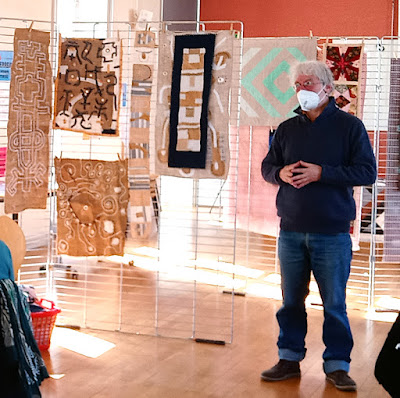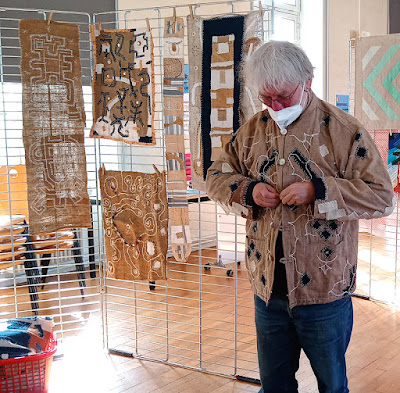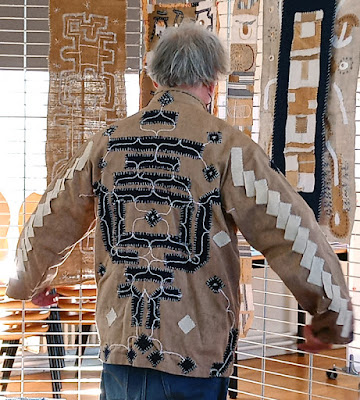Il est temps de revenir sur notre Journée d'Amitié, et vous montrer les beaux ouvrages.
It's time to look back on our Guild's Friendship Day, and show you the beautiful works.
Attention, cet article est long, et avec plein de photos 😇
Warning, this post is long, and with lots of photos 😇
Nous avons organisé notre Journée France Patchwork en 2 temps : une présentation de travaux réalisés par un artiste local le matin, puis l'après-midi, la fabrication d'une pochette avec la technique du Boro.
We organized our France Patchwork Day in 2 parts: a presentation of works made by a local artist in the morning, then in the afternoon, the making of a pouch with the Boro technique.
Quelques pièces ont été accrochées sur les grilles d’exposition, et ont commencé à éveiller la curiosité et l’intérêt des patcheuses présentes. Les tissus bruts, les grands points, les coquillages intégrés, les couleurs naturelles, tout attire le regard et invite à regarder de plus près.
In the morning, Therese, our active member, arrived with her guest, a gentle looking man with white hair, a laundry basket in his arms filled with embroidered textiles.
A few pieces were hung on the display racks, and began to arouse the curiosity and interest of the quilters present. The raw fabrics, the large stitches, the embedded shells, the natural colors, all catch the eye and invite a closer look.
 |
| (Cliquer pour agrandir / Click to enlarge) |
Notre invité est Jean-Michel Douche, un spécialiste de la calligraphie, et
de la culture tibétaine et bouddhiste. Il est l’auteur du livre Comme un lotus : écriture et sagesse tibétaines, préfacé par Matthieu Ricard, qu’il a signé de son nom
d’artiste, Jigmé Douche. Il a également publié Poèmes tibétains de Shabkar, et a participé au jury du Meilleur
Ouvrier de France en calligraphie.
Ce bagage artistique, il l’a récemment transposé à l’art
textile.
Le déclencheur a été une maladie, un cancer qui a demandé à
canaliser sa créativité sur une activité à travers laquelle il peut se
reconstruire, se réparer.
Pièce après pièce, Jean-Michel présente son travail et se
dévoile devant nous. L’inspiration est clairement chamanique, chinoise,
précolombienne, et représente sa vision du monde, de soi, sa relation au temps
si particulière pour lui.
Our guest is Jean-Michel Douche, a specialist in calligraphy, Tibetan culture and Buddhism. He's the author of the book Comme un lotus : écriture et sagesse tibétaines, prefaced by Matthieu Ricard, which he signed with his artist name, Jigmé Douche. He has also published Shabkar's Tibetan Poems, and has participated in the jury of the Meilleur Ouvrier de France in calligraphy.
This artistic background, he recently transposed it to textile art.
The trigger was an illness, a cancer that required him to channel his creativity into an activity through which he can rebuild and repair himself.
Piece after piece, Jean-Michel presents his work and reveals himself to us. The inspiration is clearly shamanic, Chinese, pre-Columbian, and represents his vision of the world, of himself, his relationship to time so special to him.
Il enfile une veste qu’il a porté au mariage de son fils, et attache un à un les boutons nacrés chinés dans un vide-grenier. Il passe le doigt sur les pièces appliquées à la main, pour nous expliquer les grands L imbriqués qui forment un motif de dragon, les poignets rapiécés avec le tissu indigo, les broderies main qui unissent les pièces.
He puts on a jacket he wore to his son's wedding, and attaches one by one the pearly buttons he found at a yard sale. He runs his finger over the hand-appliqued pieces, explaining the large interlocking L's that form a dragon pattern, the cuffs patched with indigo fabric, the hand embroidery that binds the pieces together.
He pulls from his laundry basket a large plaid, made of jeans, shirts, various recycled fabrics, assembled edge to edge with a large white thread. Thus there is no real front or back to this plaid, and this is the desired effect: on the same background, the two sides are decorated differently. On one side, white triangles like tortoise shells guide the eye in wide movements, and on the other, rectangles arranged in an arc bring the eye to the center.
Merci beaucoup Jean-Michel pour cette présentation passionnée et passionnante, et pour votre mot de la fin : « osez la curiosité ! »
Visibles sur les deux faces, de grands points droits traversent le plaid de part en part dans de larges volutes. Pour éviter que les bords ne s’enroulent, un gros fil est passé tout autour dans un ourlet, il fait office de biais de finition pour tendre et ajuster les tensions entre les différents tissus.
A travers chaque pièce, il nous raconte sa démarche de création, et se raconte à travers son art textile. Il montre les matériaux dont il s’est servi : les sacs de grain et de farine, les bandes de lin teintées au thé et séchées au vent pour ajouter des effets particuliers, des coquillages, les dreadlocks (mèches de cheveux emmêlés) de son fils, la teinture indigo qui permet de réunifier les tissus colorés, le crayon et la peinture, une grande pièce de calligraphie ancienne qu’il a dessiné sur du lin, le jean démonté et l’usage de chacun de ses éléments dans un but précis.
Jean-Michel évoque son rythme de travail, calé sur celui de la nature, méditatif, et surtout sans contrainte. Il s’arrête quand ça coince, ou quand il perd cette sérénité.
Visible on both sides, large straight stitches cross the plaid from one side to the other in large swirls. To prevent the edges from rolling up, a large thread is passed all around in a hem, it acts as a binding to tighten and adjust the tensions between the different fabrics.
La pièce suivante est un vêtement, un « capucho », qu’il a réalisé en 15 jours, sans dessin préparatoire. Il s’est laissé guider par la matière, un sac à grain usagé, déchiré, et l’a rapiécé, peint, embelli avec des pièces de tissus blanc, ocre, indigo.
The next piece is a garment, a "capucho", which he made in 15 days, without any preparatory drawing. He let himself be guided by the material, a used, torn grain sack, and patched it, painted it, embellished it with pieces of white, ochre and indigo fabric.
Chaque grand point des broderies qui couvrent le vêtement participe au travail de réparation de soi. Avec ce capucho, il a essayé de transposer une vision chamanique, dans un but de protection.
Each large stitch of the embroidery that covers the garment participates in the work of self-repair. With this capucho, he tried to transpose a shamanic vision, with the aim of protection.
Through each piece, he tells us about his creative process, and about himself. He shows the materials he used: grain and flour sacks, strips of linen dyed with tea and dried in the wind to add special effects, shells, his son's dreadlocks (strands of matted hair), indigo dye that reunites colored fabrics, pencil and paint, a large piece of ancient calligraphy he drew on linen, disassembled jeans, and the use of each of its elements for a specific purpose.
Jean-Michel evokes his work rhythm, in tune with nature, meditative, and above all without constraint. He stops when things get stuck, or when he loses his serenity.
Sa technique est simple, c’est principalement de l’appliqué main, sans ourlet, et de la broderie d’inspiration sashiko et boro. Son travail est organique, il recherche surtout le mouvement, et du sens dans le placement de chaque pièce et l’usage de chaque matériau.
His technique is simple, it is mainly hand appliqué, without hemming, and Sashiko and Boro inspired embroidery. His work is organic, he looks for movement, and meaning in the placement of each piece and the use of each material.
Il nous invite à penser autrement, à reconsidérer un carré sous l’angle de ses 8 directions : les 4 côtés mais aussi les coins. Son œuvre illustre la vision tibétaine : chaque pièce peut être regardée dans toutes les directions, avec souvent une préférence pour la « vue du ciel ». Cela permet de compléter, d’ajouter des points, des éléments, avec la question que nous nous posons tous sur notre propre travail : quand est-ce suffisant, et pas trop ? Savoir s’arrêter et contempler son travail.
He invites us to think differently, to reconsider a square from the angle of its 8 directions: the 4 sides but also the corners. His work illustrates the Tibetan vision: each piece can be looked at in all directions, often with a preference for the "sky view". This allows us to complete, to add points, elements, with the question we all ask ourselves about our own work: when is it enough, and not too much? Knowing how to stop and contemplate your work.
Merci beaucoup Jean-Michel pour cette présentation passionnée et passionnante, et pour votre mot de la fin : « osez la curiosité ! »
Thank you very much Jean-Michel for this passionate and exciting presentation, and for your final word: "dare curiosity!"
L'après-midi a ensuite été consacré à la technique du Boro, et nous avons essayé de mettre en pratique ces bons conseils. En s'aidant de la fiche d'animation, les patcheuses ont créé une pochette qu'elles ont brodé, et embelli, au gré de leur inspiration.
Mais cet article est déjà bien long, je vous remercie d'avoir lu jusqu'ici, et je vous raconterais la suite plus tard !
The afternoon was then devoted to the Boro technique, and we tried to put these good tips into practice. With the help of the animation sheet, the quilters created a pouch that they embroidered, and embellished, according to their inspiration.
But this post is already quite long, I thank you for reading this far, and I will tell you the rest later!
-------------------------------------------------
👀 Join me from Saturday to Wednesday for the Patchwork & Quilts link party 👀
-------------------------------------------------














Commentaires
J'ai adoré ta page ..quel talent a ce monsieur , surtout une imagination debordante
J'aime la petite phrase "osez la curiosité "
Merci pour ton partage
Bises
Cette journée devait être très riche pour toutes les personnes présentes.
Belle journée Fred, bisous.
Lylou
Bisous et bonne journée
Je retourne à ma campagne pour mon blog.
Bonne journée.
Cela me plairait bien de rencontrer cet artiste
Frederique what a wonderful post! Thank you SO much for sharing it on To Do Tuesday.